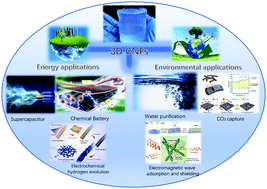Carbon nanofiber-based three-dimensional nanomaterials for energy and environmental applications
Abstract
Carbon nanofibers (CNFs) not only retain a similar one-dimensional nanostructure, similar special properties, and similar multi-functionality to carbon nanotubes, but they also exhibit a few advantages, like easier production, lower cost, lower crystallinity, and more defects. Therefore, CNF-based nanomaterials have been widely used for applications relating to energy conversion/storage, catalysis, sensors, adsorption/separation, and biomedical engineering. Due to their high specific surface area, interconnected porous structure, light weight, and high mechanical strength, CNF-based three-dimensional (3D) nanomaterials have attracted more and more attention in many fields, especially in energy production/storage and environmental science. In this work, we demonstrate the development of CNF-based 3D nanomaterials for applications relating to energy and environmental science. To achieve this aim, typical design strategies for the production of CNF-based 3D nanomaterials, including electrospinning, chemical vapor deposition, templated synthesis, hydrothermal synthesis, and other combined techniques are introduced and summarized, and then cases involving fabricated CNF 3D nanomaterials for supercapacitors, fuel cells, electrochemical batteries, water purification, air cleaning, and microwave/radiation adsorption are presented and discussed. This study will be helpful for readers to understand the production of CNFs, and the subsequent design and fabrication of functional CNF-based 3D nanostructures and nanomaterials; meanwhile it will be valuable for promoting the advanced applications of CNF-based nanomaterials in different fields.



 Please wait while we load your content...
Please wait while we load your content...